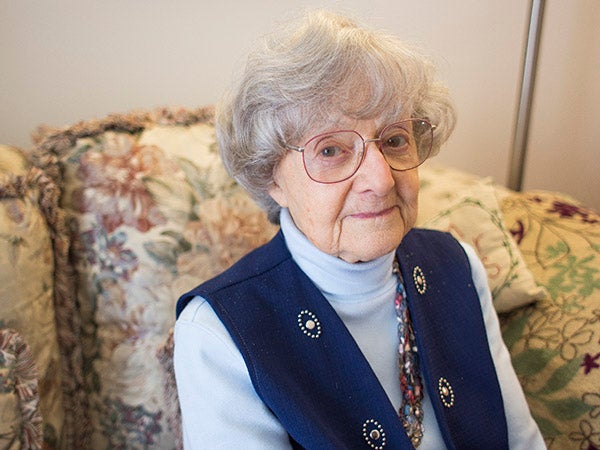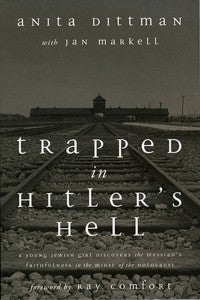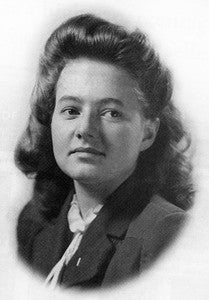Escaping a nightmare: Woman shares horrors of concentration camp and aftermath
Published 11:17 am Monday, April 27, 2015

Anita Dittman came to the U.S. with her mother as refugees in 1946 after enduring 13 years of persecution under Adolf Hitler and his Nazi regime. — Colleen Harrison/Albert Lea Tribune
Editor’s note: This is the second in a two-part series about Holocaust survivor Anita Dittman.
Read the first part of the series here.
The website for the United States Holocaust Memorial Museum describes the Holocaust as “the systematic, bureaucratic, state-sponsored persecution and murder of six million Jews by the Nazi regime and its collaborators.”
Those persecuted during that time in World War II-era Germany are called Holocaust survivors.
Anita Dittman calls it surviving Hitler’s hell.
Dittman was born in 1927 to an Aryan father, Fritz, and a Jewish mother, Hilde, in Breslau, Germany. When Dittman was 16, her mother was taken to Camp Theresienstadt in what was then referred to as Czechoslovakia. Nine months later, Dittman was told to report to a train station, where she would be taken to her “final destination,” or what the Gestapo called her assigned concentration camp.
Life in the camps
Dittman arrived at Camp Barthold in August 1944. She and the rest of the women she was with were housed in a dirty, old cow barn. Having never been cleaned out, straw had simply been thrown over the ground of the barn. The women were given old horse blankets and were told to pick a spot on the ground to sleep on. The men were housed in old horse stables. Dittman said there were two married couples in the camp that were not permitted to live together, but were able to see each other when working.
She said there were about 300 people at the camp, split pretty evenly between men and women, ranging from ages 15 to 65.
The prisoners were woken up at 4 a.m. the next day and told to get dressed and to stand in formation. They were told they were now working for the country, for the Führer, and that they should feel honored. They were given a piece of bread and a bit of imitation coffee, and were then counted and recounted, all while being verbally and sometimes physically assaulted.
Afterward, prisoners were then marched off with picks and shovels to vacant fields to dig ditches. Dittman said the ditches were about 8 to 10 feet deep, 10 to 15 feet wide and many kilometers long. They were meant to be traps for tanks should Russian troops invade.
The routine was the same every day. She said their heads were never shaved and numbers were never burned into their arms, leading her to believe that they were better off than some camps, especially Auschwitz.
Winter came, and according to Dittman, Hitler was as delusional as he ever was.
“Hitler always said we were winning because he was demented,” she said.
Camp Barthold’s occupants were moved to another location, where prisoners would then work in the forest cutting down trees to act as reinforcements for the ditches.
In the meantime, prisoners caught head lice from each other, and the authorities took their time in getting them medication. The cold weather brought on harsh conditions. Dittman said she had a blister on her foot that had opened and was impossible to keep clean, and that she contracted blood poisoning. She said the guards were under the impression that if the prisoners couldn’t work, they shouldn’t live, so she knew that if she told them of her ailment she’d either be clubbed to death or shot on the spot.
Dittman said it was shortly before Christmas in 1944 that prisoners were told they would be shipped off to the ovens at Auschwitz once their work had been completed.
On Jan. 23, 1945, the prisoners were told to line up in formation one evening. They were told that they would be marched off to yet another new location as it was rumored that Russian troops were encroaching on the camp’s land.
Three brothers in the camp decided that this would be their chance to escape. They invited Dittman and one of her friends — also named Hella, like Dittman’s sister — to join them on their journey. The girls accepted, until Dittman told another friend of hers at the camp, named Christian, of their plan. When she tried to convince Christian to come with them, he told her that it was too dangerous and that she should stay at the camp as well. Dittman and Hella eventually conceded and decided to stay at the camp. Dittman would later find out that those who had tried to escape that night were eventually captured by the Gestapo and taken to an apartment building that had a bomb dropped on top of it. None survived.
A chance to escape
Dittman and her fellow captives were marching back to camp one night when they passed a number of villagers fleeing their homes nearby. They found out that the Russians were on their way and would be in the vicinity of the camp by the next morning. Dittman said the Russian troops were notoriously known for their treatment of the women they came across when invading. When the prisoners returned to their camp, the women were locked up tight and surrounded by guards who had guns with bayonets attached at the end.
Dittman was one in a group of five women who had become close through a shared Christian faith, and said all five women stayed up that night holding hands and praying.
Early the next morning, all of the women in the camp were loaded up into a horse-drawn wagon and were sent off to a different location. They were escorted by two guards on bicycles and were driven by Polish prisoners of war. While stopped at one point, Dittman said three of her friends managed to escape into the forest. When one of the Nazi guards sent Dittman and her friend Hella with one of the POWs to head them off at the nearest railroad station, they saw their chance to escape.
Dittman said they were able to bribe their driver with cigarettes and the money from Dittman’s mother that she had managed to hide in her clothing throughout her stay in the camps. The POW dropped the two girls off at the station, where they were reunited with their three other friends who had escaped earlier.
At the station they found a long train with cattle cars, German soldiers and one passenger car, with the rest of the train consisting of flatbeds that carried demolished Russian army tanks to be repaired and used by German troops in a city near Berlin.
With Dittman being able to pass as an Aryan with her long, blonde hair, her friends encouraged her to go up to one of the soldiers and talk their way onto one of the cars.
“I was cute then, I have to admit,” she said.
Dittman told a soldier they were villagers that had been separated from their families while running from the Russians, and that they were very afraid. The soldier, not knowing that they were escaped Jewish prisoners, allowed them to stow away in one of the tanks with two other soldiers. One of the soldiers made it clear to Dittman that she should seek medical attention at once for her leg, which was badly infected by that time.
Once off of the train, the girls worked their way through the firestorm in Dresden and found a hospital in Bautzen where they dropped Dittman off, as a few of them had family in the area to stay with.
At the hospital, Dittman was greeted with a “Heil Hitler” by a Nazi nurse. She was careful not to reveal who she really was and what she had escaped from, and was admitted with a 105-degree fever.
She said she had to wait days before there was a doctor available to perform surgery on her. Once she was finally operated on, she was put under using ether as anesthesia. One of the side effects of the substance was talking while sleeping, and when Dittman woke up after surgery she could deduce from the nurse’s behavior that she had revealed too much in her unconscious state.
The Nazi nurse couldn’t say anything due to her professional oath, but Dittman knew that there was a medal waiting for every Nazi that killed a Jew, thanks to Hitler.
“She took it upon herself to kill me,” she said.
Dittman said the nurse mocked her and ridiculed her, and did everything in her power to work against the doctor’s medical treatment of Dittman. She made sure nothing was sanitized, aggravating the open wounds from Dittman’s surgery. When the doctor told Dittman she’d need another operation, she knew it would be a chance for the nurse to literally do her dirty work. The nurse continued her unsanitary ways, going as far as giving Dittman an enema and leaving her on a bedpan for over two hours, leaving the open surgical wounds on Dittman’s thighs vulnerable to her own bodily waste. As expected, the infection in her leg continued to spread, worsening as it did.
When Hella came to visit her friend in the hospital, she was appalled, and immediately sought out Dittman’s doctor. The doctor had been unaware of her condition, saying that the nurse had been telling her Dittman’s health was progressing. She went to examine Dittman, seeing that she needed another operation right away. The doctor managed to relocate the Nazi nurse to another part of the hospital, and set about trying to save Dittman’s life, and her leg.
Following the surgery, Dittman woke to find she still had her leg. With her condition being all too close to death, she was not allowed painkillers or any ether to dull the pain. Eventually, as she recovered, Hella helped her learn how to walk again.
Weeks later, as Dittman was walking the floor for exercise, she heard sirens in the distance. It wasn’t an air raid, but a message signaling that the Russians had invaded. It was only a matter of time before they’d be at the hospital, the tallest building in the area.
Once the Russians took over the hospital, all of the men, women and children were pushed into one room used as shelter from air raids. Women were being raped by Russian soldiers right before everyone’s eyes, and Dittman said she feared what she thought was the inevitable.
A soldier grabbed her, and another soldier helped him push her down onto a mattress and rip her clothes off. The men saw her stained bandages and, thinking they must be for show, had a student nurse take them off. When they saw Dittman’s garish-looking wound and her cut-up leg, they were revolted enough to leave her alone and move onto someone else.
One night soon after, Dittman was walking the floor once again in attempts to gain her strength back. She found a woman curled up in a corner weeping, and realized it was the Nazi nurse who had tried to kill her. Initially, Dittman was too angry to even think of attempting to comfort the woman. It wasn’t until she heard the nurse cry out — in between sobs — that she had been raped multiple times by the Russian soldiers, that Dittman sat beside her and cried with her and tried to offer her some sort of comfort.
“All my bitterness was gone,” she said. “I felt so sad. I thanked God that I had been spared from that.”
“How can you possibly comfort me? Don’t you realize I tried to kill you?” the nurse asked Dittman.
Dittman’s only reply to the nurse was that she forgave her. She said the war had done a number of terrible things to a number of people. It had brought out the worst in some, and Dittman said she refused to be one of them.
She never saw the nurse again.
Weeks later, the Russians had — for the most part — been driven out of the area. Dittman said that ambulatory patients were being shipped out to a different location. As she was healing, she was bandaged up and told to be on her way.
A long-awaited reunion
On April 30, 1945, as Russian troops surrounded Berlin, Hitler shot and killed himself.
“Hitler never gave up until the enemy was at his doorstep,” said Dittman.
While the war may have been over, Germany was left in shambles.
Dittman was gradually working her way to Czechoslovakia, to the camp her mother had been imprisoned in. She walked and hitchhiked to a train station in Bautzen. She managed to put together just enough money to obtain passports in Czech, Russian and English, as well as passage into Czechoslovakia. She was told that Czechs did not take kindly to German-speaking individuals, and that if she didn’t know any other languages she should pretend to be a deaf mute.
From Bautzen Dittman took a train to Prague, and then took another train to Leitmeritz. From there she hitchhiked to Camp Theresienstadt. Along the way, Dittman had heard that the camp’s prisoners were ordered to build the gas chambers that they would ultimately be executed in. After stalling in their construction, the camp was liberated the day before their planned mass execution. Even though the camp was said to have been liberated, news was also being circulated that many had died in the process.
Knowing what she did, it was hard for Dittman to walk onto the grounds, which were now a Displaced Persons camp, knowing that her mother might not be there waiting for her on the other side.
About one month after the war had ended, on June 7, 1945, after waiting for what seemed like hours for her mother to be found in the records of survivors, Dittman and Hilde were reunited.
“When I came face to face with her, we couldn’t say anything,” said Dittman. “We were just so amazed.”
Hilde told her that she had been invited to journey back to their hometown that very same morning, but she had decided not to. If her mother had gone back, Dittman said she never would’ve seen her again.
The end of the journey
After finally being reunited, Hilde and Dittman tried to find a way to England to see Dittman’s sister, Hella, again. With the country being completely poverty-stricken, it was impossible. Mother and daughter were in a DP camp in Bavaria for about seven months before applying to the American Christian Committee for Refugees.
On June 7, 1946, exactly one year after their reunion, they left from Bremen on the SS Marine Flasher with about 900 other refugees on their way to the United States.
On June 17, they arrived in Ellis Island, after passing the Statue of Liberty.
“It was so beautiful,” said Dittman. “Finally, after 13 years that we had prayed that someday we would be free.”
Dittman, 19 at the time, said that all 900-some passengers came to the deck to take in the sight.
“There were no words,” she said. “No speech. Just sobs of gratitude and relief. It was beautiful.”
Life in the U.S.
Hella finally reunited with Hilde and Dittman in 1961 when she came to the U.S. for a visit. She stayed with them for three weeks before returning home to London. Three years later, she died from cancer.
Dittman eventually moved to Iowa from New York. She went to college, graduated and got married.
“I finally had a home again,” she said. “I had security.”
Shen then lived in Missouri before moving to Minnesota.
Dittman has two children, Floyd and Jeanette, who live in the Twin Cities area, as well as four grandchildren. She lives in Ham Lake with her husband, Fred Rowden.
In the mid-1970s, Dittman wrote a book about her story with the help of Jan Markell. Originally called “Angels in the Camps,” her publisher told her the memoir was too long and needed to be condensed. Her memoir is now called “Trapped in Hitler’s Hell,” and can be found on Amazon. Dittman has traveled all over the U.S. telling her story, and spoke Sunday at First Lutheran Church in Ellendale.
In the mid-1980s, Dittman’s mother died from a heart attack at the age of 89. Dittman said her mother died peacefully in her sleep, with Dittman by her side.
“She had a hard life,” said Dittman. “She deserved an easy death.”
Dittman said that her father died of cancer at one point. It became apparent to her that cancer ran on her father’s side of the family, while heart disease ran on her mother’s side. After surviving two heart attacks herself, Dittman said she has been asked if the thought of dying that way scares her.
“After what I’ve seen, why should I live to be scared of what I die from?” she said. “You can’t live that way.”
Video from the Tribune’s interview with Dittman can be seen here.







